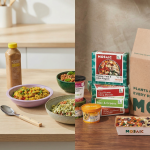NOSH Voices: Vermont’s GMO Law: Small State, Big Shakeup
About the Author: This post was written by Rebecca Cross and Allison Hagey on behalf of BraunHagey & Borden LLP, a boutique law firm representing food companies nationwide by providing full-service legal advice.
It’s a new era in Vermont, and it started on July 1, when Vermont Act 120 went into effect. The Act requires labeling of food produced with genetic engineering (“GE” or “GMO”). But before you start to pack your picnics with disclaimers, a few considerations are worth keeping in mind: first of all, The Act obligates manufacturers to make disclosures, not picnic hosts. Second, Vermonters don’t get to have all the fun. Statewide acts such as this Vermont one can have larger ramifications for an entire business’s product line, even if you only sell a small amount of product in Vermont.

The Act is not yet fully baked, with opposition from groups such as the Grocery Manufacturers Association challenging it in federal court as interfering with interstate commerce. A federal district court rejected the request for an injunction and an appeal is still pending. In March 2016, the federal government took up the issue with the U.S. House of Representatives attempting to pass a national bill that would have blocked Vermont from implementing its mandatory GMO labeling law. The bill failed to gain the 60 Senate votes needed for it to pass. With divided support, we await another attempt by Congress to pass a national labeling law that could either support the Vermont efforts or preempt it.
In the meantime, a food business is forced with the difficult choice of incurring additional expenses to change their product label now to be in compliance by the Vermont deadline or gamble that the Vermont attempt will fall by the wayside and we’re back to labeling status quo. Or, rather, status quo until 2018 when the new Nutrition Facts Label goes into effect.
As lawyers, it’s hard to recommend unnecessary expenses to clients by reading tea leaves, or maple leaves in this context. The leaves, however, reflect a national trend and movement towards more transparency in our food supply. This is not unchartered waters, albeit a lot has changed and momentum around transparency has grown since California’s 2012 failed attempt to pass their GMO labeling law. Although California’s Prop 37 did not pass, other states, encouraged by the attempt, including Connecticut and Maine, passed GMO labeling laws that will go into effect when at least four other states pass similar measures. In addition to the other states following the transparency trend with legislation, larger food manufacturers are listening and often leading the effort. Campbell’s Soup announced in January their support of mandatory national GMO labeling and created a label for products sold in Vermont. Campbell’s has provided GMO information accessible online about all their products. Other large companies including General Mills, Mars, Kellogg, and ConAgra Foods have all announced a national rollout of GMO labeling. Helping to spur this momentum is perhaps the 80 million American millennials, with half of them identifying as part of “Generation Yum.” They are catalyzing many of these changes in the food system with their demands for transparency and GMO labeling.

As food companies know, individual state-by-state compliance to specific labeling requirements is expensive and often necessitates a complete overhaul of your entire product line label. This column in no way offers legal advice, it’s a column. However, if you do choose to modify your label, keep in mind the several ways you can comply and options for how you label your product.
Compliance with the Vermont Act include the following options:
- Formal Statements from Suppliers. Companies can comply with the Act by obtaining statements from each of their ingredient suppliers that the ingredient is not produced with genetic engineering,
- Non GMO Project Verification (or verification by NSF International),
- Organic certification,
- Verification of Trace GE Content. Foods are exempt if the aggregate weight of the GE materials is no more than 0.9 percent of total weight of food (precooked/baked), exclusive of added water and salt, or
- Disclosure on your label that your product is partially produced with genetic engineering. Only use “partial” if your product contains less than 75% or more GE material, by weight. You can consider including a statement that the FDA does not consider food produced with genetic engineering to be materially different than other food.
The Act prohibits use of the word “natural,” “naturally,” or “nature” if you contain any GE ingredients. Don’t use the word natural if you have any GE ingredients.
As mentioned, we’re not fans of reading any type of leaves, but signs point to upcoming change and we remain eager to see how this all unfolds.
At Project NOSH and BevNET we pride ourselves on having a robust network of food and beverage entrepreneurs, industry insiders and advisers. To that effect, NOSH Voices is a series of columns by respected experts to provide a spectrum of points of view from within the community. Interested in contributing as a NOSH voice? Contact the Editors.
















